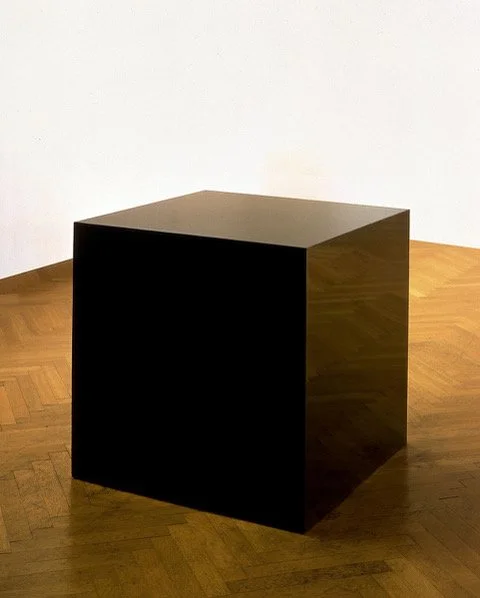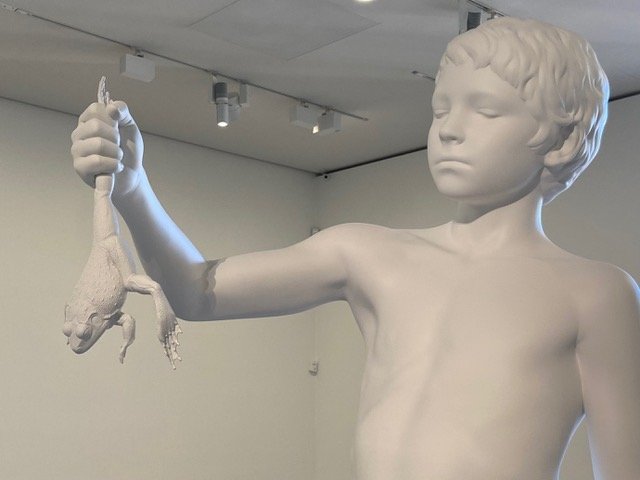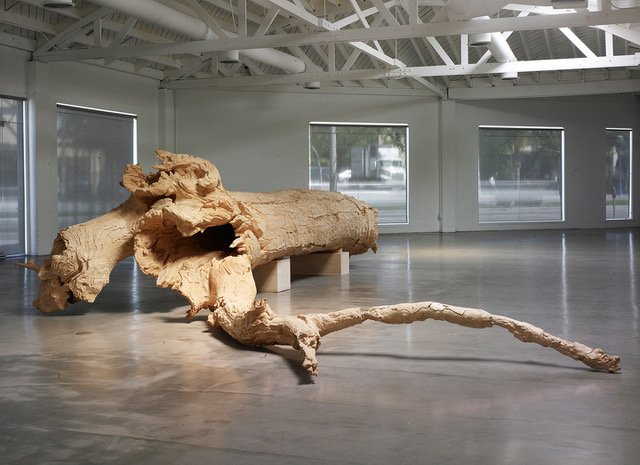A Sculptor for Our Time
Charles Ray at the Bourse de Commerce / Centre Pompidou
There is an exhibition currently on at the Bourse de Commerce-Pinault Collection which is also on at the Centre Pompidou about a sculptor, Charles Ray. Who may not be a household name. But here is what he has to say about sculpture - “it embodies four dimensions .. the three dimensions of space and that of time”. Exactly how Michelangelo explained why sculpture is better than painting. We’re off to a good start.
Charles Ray was born in 1953. His family ran a commercial art school they inherited from Ray’s grandmother. History being destiny, Ray attended art school in both Iowa and New Jersey. Doesn’t sound all that romantic, but it worked for him.
Just out of art school, Ray dabbled in Performance Art, hanging himself up against the wall in one surviving photo, tying himself to a tree in another. (Figures 1, 2) He remembered this about his sculpture classes, “once a sculpture was completed it was critiqued and put back on to the scrap pile.” Process over product. Like performance art where the journey is the destination, where the doing is the being.
Figure 1. Plank Piece I / II, photographs, 1973, Charles Ray
Figure 2. Untitled, 1973, Charles Ray
In 1981, at 28, Ray moved to California to teach in the sculpture department at UCLA. He’s been there ever since. Early on, he worked with ink and wire. ‘Ink Box’ from 1986 is a large cube filled to the brim with ink. (Figure 3) It looks like a solid cube. It isn’t. As anyone who touched it found this out the hard way. I read somewhere that during the exhibition there was a growing pattern of finger and hand prints on the walls around the piece.People trying, unsuccessfully to remove the ink from their hands.
Figure 3. Painted steel box and ink, 1986, Charles Ray
Since the early 1990s, Ray’s work has combined the huge scale of abstract Modernist sculpture (think Anthony Caro, Figures 4) with hyper realism. It can be very creepy. Especially the early works in fiber glass and fabric. His contemporaries, like Kiki Smith (Figure 5) and Jeff Koons were exploring figurative art at about the same time, but here is how Ray happened upon Big and Real. During college, he worked for a time as a night janitor in a department store. He became more familiar with store mannequins than with store patrons.
Figure 4. Anthony Caro
Figure 5. Kiki Smith
According to one critic, Ray became obsessed with mannequins because they are ‘generic, factory-produced representations of humans”. While another critic suggests that at the time, mannequins were “arguably the most visible examples of contemporary figurative sculpture on America’s vast consumerist landscape”. Okay.
An early example of Ray’s made to order fiberglass mannequins is Boy. (Figure 6) Which you can see now, at the Met in New York, where there is also an exhibition of Charles Ray sculptures. Boy is an example of what can happen when real meets big. Boy is a little boy, in an outfit from the 1950s. An outfit surely selected by his mother. White button down embroidered shirt with elbow length sleeves. A pair of baby blue shorts with suspenders. White knee socks and black sandals. Boy is very pale. He’s a redhead. Boy is 6 feet tall. Soft as a boy, tall as a man. Is his pose confrontational? Is he pointing his finger directly at the observer? One critic wrote that Boy hovers “between baby and Hitler youth,” Yep, that about sums it up.
Figure 6. Boy Painted fiberglass, steel, fabric / 71 1/2 x 27 x 34 inches, 1992
Things got bigger. And creepier. Fall ’91 (Figures 7, 8) is a fiberglass mannequin in a pink power suit with her hair styled just so. She’s eight feet tall and not just in your mind. Hands on her hips, hair perfectly coiffed, lipstick applied to perfection. Be careful.
Figure 7. Fall ’91, painted fiberglass, clothes, hair, jewelry, glass, steel, 96 x 26 x36”, Charles Ray, 1992
Figure 8. Fall ’91 and me
Creepier still when Ray decided to strip his mannequins bare. “Family Romance,” is the nuclear family writ large (or small). Mom, dad. two kids. (Figures 9, 10) They are holding hands. They are naked. They are anatomically accurate. They are the same size. The parents are too small, the kids are too big. The little boy and littler girl are sexually immature, softer, rounder, less defined. Yet they seem to be larger than their parents. What does it mean? Is everyone equal? Are kids more equal than their parents? Does this mean that the younger the child, the more important the child? Do children dominate their parents in American society? Do men and women shrink in their individual importance when they assume the role of parents? There’s a lot going on here and your Freudian hang-up/interpretation is as good as mine.
Figure 9. Family Romance, painted fiberglass, hair, Charles Ray, 1993
Figure 10. Family Romance, Mixed Media, Charles Ray, 1993
Just one more of Ray’s forays into fiberglass. A 1992 installation called Oh! Charley, Charley, Charley… (Figures 11, 12) My husband’s name, except he spelled it Charlie and I said it with a sigh, which is how I am repeating it in my head as I write. But this is not a sigh inducing group. It is a naughty group, hidden behind a curtain at the Bourse. You have to stand in line to see it. And then you see it with a few strangers while other strangers wait for you to finish looking so they can look, too. And what is all the secrecy about? Oh, just eight identical and anatomically accurate naked mannequins. All likenesses of Ray. All engaged in a ballet-like orgy of limbs and limps (does that work as a euphemism?). No one is actually touching anyone else. Mouths are open but empty. Eyes are open, but stares are blank. I asked the friend I was with, a Frenchman, if heterosexual orgies are this calm. I figured if anyone would know it would be a Frenchman. He didn’t answer. Guess that’s a no.
Figure 11. Oh! Charley, Charley, Charley, painted fiberglass, synthetic hair, Charles Ray, 1992
Figure 12. Oh! Charley, Charley, Charley ….. and me
Apparently Ray wasn’t shooting for pornography. What he told a critic was that he was aiming for a multi-figural sculptural composition that could stand on its own with, for example, Rodin’s The Burghers of Calais. (Figure 13) Ray also said, ‘I was thinking your lover is not there. Your lover is just a projection of yourself. There’s only one person in the universe and it’s you.’ Makes orgies kind of a waste of time, I suppose.
Figure 13. Burghers of Calais, bronze, Auguste Rodin, 1884-89
In the 2000s, Ray moved from fiberglass to stainless steel and with it, a move towards timelessness. Sort of. For example, one piece entitled School Play (Figure 14) is a young boy dressed as a Roman Senator wearing a toga and sandals and holding a sword. But as Jason Farago so accurately notes, the toga is a bedsheet, the sandals are plastic and so is the Made in China sword.
Figure 14. School Play, solid stainless steel / 76 x 23 x 15 1/2 inches, Charles Ray, 2014
Other statues refer to Classical or Renaissance precedents but playfully upend those statues with models that negate rather than celebrate the ideal form. Ray’s models slouch or they’re bald or they’re out of shape or they’re all three. (Figure 15, 16) The ideal is recalled only to be ridiculed. And then there is Boy with Frog (Figure 17) from 2009. It was commissioned by François Pinault (the owner of the Bourse de Commerce) to stand in front of his other museum, Punta della Dogana, in Venice. Passersby were not pleased. (Figure 18) A Facebook protest campaign was launched and the statue was removed in 2013. But we can see it here. And I think it is lovely.
Figure 15. Burger, fiberglass, Charles Ray, 2021
Figure 16.Young Man, solid stainless steel, Charles Ray, 2012
Figure 17. Boy with Frog. Painted stainless steel, Charles Ray, 2009
Figure 18. Boy with Frog, in situ, Venice (2009-2013)
A young nude boy holds aloft a wriggling frog. He is 8 feet tall. He and the frog are stainless steel, painted white. To me the boy is the adolescent David (slayer of Goliath) by Renaissance artists like Andrea del Verrocchio and Donatello (Figures 19, 20). Soft, bellies slightly protruding, hips pushed forward. Combined with the pose of Benvenuto Cellini Perseus holding the head of Medusa (Figure 21).
Figure 19. David, Andrea del Verrocchio
Figure 20. David, Donatello
Figure 21. Perseus holding the head of Medusa,Benvenuto Cellini,
Here is how Ray explained it to Jason Farago in 2015. He was scheduled for major heart surgery and the image of a boy and a frog immediately popped into his mind. (Figure 22) ’The first thing we do in secondary school, in science class, is take a frog apart, look inside, and see the heart. I’ve wondered over the years if the frog is also my heart, if that’s where it came from.’
Figure 22. Boy with Frog, detail
Staying in the vein of celebrating Renaissance prototypes only to deflate them, there is a Doubting Thomas (Figure 23) that recalls only in the loosest way the noble statue that Verrocchio sculpted for Orsanmichele in Florence. (Figure 24) Instead of dignified poses, floor length robes and halos, Ray has two naked guys, one of whom is sporting a James Dean haircut and both of whom are sporting impressive though different, genitalia. It’s not Christ proving he’s risen so much as it is one guy checking out another guy’s abs.
Figure 23. Doubting Thomas, painted carbon fiber, Charles Ray 2021
Figure 24. Doubting Thomas, Andrea del Verrocchio, Orsanmichele, Florence
“Horse and Rider,” (Figure 25) in solid stainless steel is another statue that upends references. Equestrian statues are usually of military men, from Donatello’s Gattamelata in Padua (Figure 26) to Daniel Chester French’s statue of George Washington in Paris (Figure 27) . The statue is a type conceived to celebrate power and authority. Which is certainly what the current despot in Russia had in mind when he posed, bare chested on horseback.(Figure 28) The Horse and Rider (Figure 29) who greet visitors to the Bourse couldn’t be less heroic. Slouched, wearing an ordinary button down shirt, holding neither reins nor weapons, this rider seems content to simply stay on the horse. Ray explains what he was after this way: ‘It’s me, I’m an old man and tired. My horse is old and tired. It’s not Joan of Arc on a pedestal, I’m down on the ground with you and your neighbor.’
Figure 25. Horse and Rider, stainless steel, Charles Ray, 2014
Figure 26. Gattamelata, Donatello, Padua
Figure 27. George Washington, Daniel Chester French, 1900, Paris
Figure 28. Putin and his horse
Figure 29. Horse and Rider et moi
There are other down and out folks either here as themselves - the homeless man, the homeless lady - or with titles referencing moments in Christ’s Passion, like Ecce Homo. (Figures 30, 31, 32) Is Ray making a statement about contemporary American society? About the invisibility of the forgotten and downtrodden? By depicting them exactly as they are but in materials that are both costly and refined, does he ask us to reconsider their worth, our own worth?
Figure 30. Concrete Dwarf, concrete, Charles Ray, 2021
Figure 31. Sleeping Woman, stainless steel, Charles Ray, 2012
Figure 32. Jeff, (Ecce Homo), marble, Charles Ray, 2021
Then there’s a reclining nude woman, hand-sculpted from paper, entitled Portrait of the Artist’s Mother. (Figure 33) She recalls all the reclining Venuses you remember from your art history classes. (Figure 34) Except that she’s masturbating (I think). She’s all white with flowers all over her. Ray is an insomniac. He draws flowers when he can’t sleep. He donated a frieze of those flowers to the Pompidou. (Figure 35)
Figure 33. Portrait of the Artist’s Mother, handmade paper, gouache, Charles Ray, 2021
Figure 34. Danae, Titian
Figure 35. Where Have All the Flowers Gone, Frieze, ink on paper, Charles Ray, 2020
At the Pompidou, on the terrace, beyond the book store, accessed through an emergency exit is a sculptural pair whose subject might loosely be Racism in America. With Mark Twain’s Adventures of Huckleberry Finn’s two protagonists, Huck and Jim as our guides. (Figure 36) Two larger than life size figures. Both nude. Both stainless steel gray. We know their race by the title and Jim’s facial features. The teenage Huck is bent over, the older Jim has his hand on the boy’s back. The pair was commissioned by the Whitney Museum. For the plaza in front of the museum. To greet visitors as they walked off the High Line and into the museum. The Whitney gave it a pass once they saw it.
Figure 36. Huck and Jim, stainless steel, Charles Ray, 2014
Here’s Ray’s explanation (2022), “I needed to embrace not just what I could make, but what America could make and what America was. I returned to the river and to Twain.” But the Whitney wasn’t ready to take the journey with him, or at least didn’t think people passing by or walking into the museum would be.
Last year he returned to Twain with another stainless steel sculpture called Sarah Williams, (Figure 37) on display at the Met, but not in Paris. Two figures, a standing woman in a long dress, hands at her side and a kneeling bald man behind her, looking up, hands on his knees. Who is Sarah Williams? Sarah is actually Huck disguised as a woman so he could come back to town find out what people were saying about him. Sarah Williams was the name that jumped into Huck’s head and out of his mouth when he was asked to identify herself.
Figure 37. Sarah Williams, Charles Ray, 2021
Ray insists that his sculptures don’t represent anybody or anything. That they are not depictions. But that seems disingenuous. Why give something a name and then deny connections. References to Twain’s book are references to race relations in America. And with this scene from that book, race is joined by gender norms and aberrations. We know that the stain of slavery in America has not gone away. That issues of sex and gender have not been resolved. This is a sculpture for our time.
I haven’t mentioned the trucks (Figure 38) that Ray deconstructs and reconstructs or the log he became obsessed with and had meticulously recreated in Japan (Figure 39) or the video of him talking about learning how to sew his own clothes, by trial and error, without a pattern, without understanding the importance of following the fabric grain.
Figure 38. Unbaled Truck, crushed truck, Charles Ray, 2021, in La Bourse de Commerce, Paris
Figure 39. Hinoki , cyprus, Charles Ray, 2007
Ray references Christian iconography and American history, literature and pop culture. He is knowledgable, too about the history of sculpture. I had a flip book in my head as I wandered through the exhibitions here in Paris and read about the one at the Met. I could see how statues by Ray of male nudes were riffing off the Greek and Renaissance ones that preceded them. I like how a material of our time - stainless steel, hollow or solid, has replaced solid marble and hollow bronze from earlier times. This guy’s work is interesting and provocative and at 69, he does what he wants to do.
Copyright © 2022 Beverly Held, Ph.D. All rights reserved
Dear Reader, I hope you enjoyed reading this article. Please click here or sign up below to receive more articles plus other original content from me, Dr. B. Merci!
And, if you enjoyed reading this review, please consider writing a comment. Thank you.







































